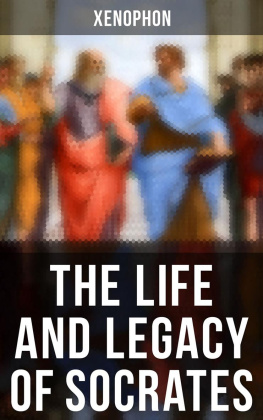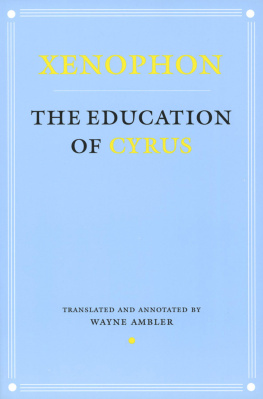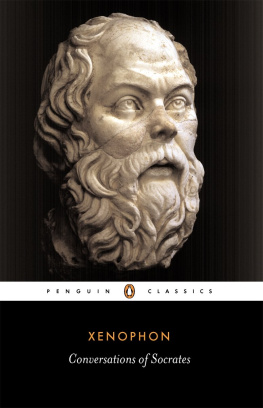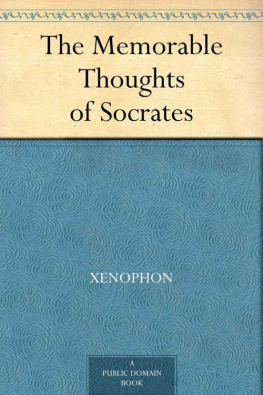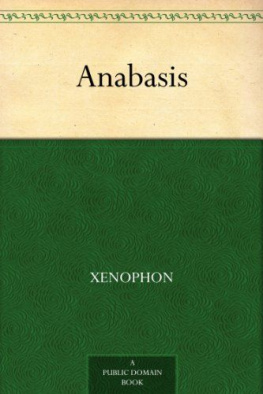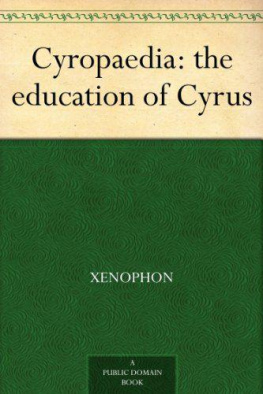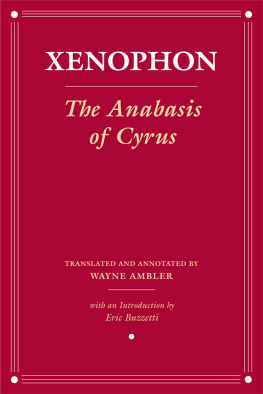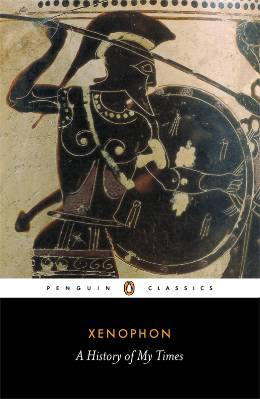Trends in Classics - Supplementary Volumes
Edited by
Franco Montanari
Antonios Rengakos
Volume
ISBN 9783110793376
e-ISBN (PDF) 9783110793437
e-ISBN (EPUB) 9783110793482
Bibliographic information published by the Deutsche Nationalbibliothek
The Deutsche Nationalbibliothek lists this publication in the Deutsche Nationalbibliografie; detailed bibliographic data are available on the Internet at http://dnb.dnb.de.
2022 Walter de Gruyter GmbH, Berlin/Boston
Xenophons Anabasis and its Reception
Trends in Classics Supplementary Volumes

Edited by
Franco Montanari and Antonios Rengakos
Associate Editors
Stavros Frangoulidis Fausto Montana Lara Pagani
Serena Perrone Evina Sistakou Christos Tsagalis
Scientific Committee
Alberto Bernab Margarethe Billerbeck
Claude Calame Kathleen Coleman Jonas Grethlein
Philip R. Hardie Stephen J. Harrison Stephen Hinds
Richard Hunter Giuseppe Mastromarco
Gregory Nagy Theodore D. Papanghelis
Giusto Picone Alessandro Schiesaro
Tim Whitmarsh Bernhard Zimmermann
Volume 134
Xenophons Anabasis and its Reception

Edited by
Tim Rood and Melina Tamiolaki

ISBN 978-3-11-079337-6
e-ISBN (PDF) 978-3-11-079343-7
e-ISBN (EPUB) 978-3-11-079348-2
ISSN 1868-4785
Library of Congress Control Number: 2022942747
Bibliographic information published by the Deutsche Nationalbibliothek
The Deutsche Nationalbibliothek lists this publication in the Deutsche Nationalbibliografie; detailed bibliographic data are available on the Internet at http://dnb.dnb.de.
2022 Walter de Gruyter GmbH, Berlin/Boston
Editorial Office: Alessia Ferreccio and Katerina Zianna
Logo: Christopher Schneider, Laufen
www.degruyter.com

To the memory of our fathers,
Pearce Rood (19332021)
& Nikolaos Tamiolakis (19412022)
Acknowledgements
This volume arose from a conference co-organised by Nikos Miltsios, Tim Rood, and Melina Tamiolaki in Heraklion (Crete), in October 2018. We are grateful to all participants for their excellent contributions and the stimulating discussion, which made this event a truly rewarding experience. The organisation of the conference was made possible thanks to the support of the Special Account of Research Funds of the University of Crete (Grant of Type B Proposals), the Department of Philology of the University of Crete, and the Region of Crete. We also wish to thank Antonios Rengakos and Franco Montanari for accepting this volume into the series Trends in Classics of Walter de Gruyter. Finally, Melina Tamiolaki would like to acknowledge the support of her research by the Foundation of Education and European Culture (IPEP, Athens).
The title of the conference back in 2018 was Anabases in Antiquity and Beyond. Xenophons Anabasis and its Legacy. Our initial aim was to offer a fresh interpretation of both Xenophons Anabasis and of other Anabases in Antiquity and modern times. However, when we started designing this volume, we realised, following also the suggestions and comments of colleagues who read an initial draft, that Xenophons Anabasis deserved in itself a more in-depth exploration, necessitated, among other reasons, by the recent explosion of Xenophontic studies. We thus decided to reconceive the scope of volume: we invited additional contributions on specific aspects or episodes of Xenophons Anabasis, so as to offer a broader coverage of readings and themes; we reduced the papers on Arrian, who initially occupied a whole section at the conference; and we considerably enriched the section on reception. We thank all contributors for their flexibility and patience, and their timely responses, throughout this long process. We are also grateful to Panagiotis Androulakis for compiling the indexes.
The volume appears four years after the conference took place. In the course of these years, several important works on Xenophon have been published, including, most notably, in 2021, the Landmark Xenophons Anabasis, edited by Shane Brennan and David Thomas. We have tried to take account of new findings and we hope that the present book will be a timely and useful addition to the (still growing) body of Xenophontic scholarship.
We would like to dedicate this volume to the memory of our fathers, Pearce Rood and Nikolaos Tamiolakis, who both passed away in the last years of the preparation of this project.
Tim Rood, Oxford
Melina Tamiolaki, Heraklion
May 2022
We have used the following abbreviations for Xenophons works:
| Ages. | Agesilaus |
| Anab. | Anabasis |
| Apol. | Apology |
| Cyn. | Cynegeticus |
| Cyr. | Cyropaedia |
| Eq. | De re equestri |
| Hell. | Hellenica |
| Hier. | Hiero |
| Hipp. | Hipparchicus |
| Lac. Pol. | Lacedaemonion Politeia |
| Mem. | Memorabilia |
| Oec. | Oeconomicus |
| Por. | Poroi |
| Smp. | Symposium |
| FGrHist | F. Jacoby, Die Fragmente der griechischen Historiker, Berlin: Weidmann, 19231930; Leiden: Brill, 19401958, 15 vols. |
| LSJ | Liddell, H.G./Scott, R./Stuart Jones, H., A Greek-English Lexicon [1843], Oxford: Clarendon Press 1996. |
| TLG | Thesaurus Linguae Graecae, University of California, Irwine. |
List of Figures
Fig. 1: Author Manuscripts per Century.
Fig. 2: Battlelines from MS V.
Fig. 3: The landwalls of Athens after Florence, Biblioteca Medicea Laurenziana, plut. gr. 69.2, 87v (10th c.). The Figure is reproduced by permission of the Biblioteca Medicea Laurenziana.
Fig. 4: Spelmans Xenophon, Frontispiece.
Fig. 5: Modern Kurds.
Fig. 6: Gails Xenophon, illustrated by Le Barbier.
Fig. 7: Households Xenophon, illustrated by Leonard Everett Fisher. The Figure is reproduced by permission of Penguin Random House.
Fig. 8: Households Xenophon, illustrated by Bernard Blatch.
Fig. 9: Witts Zehntausend, illustrated by Max Slevogt.
Fig. 10: These are the armies of the night (THE WARRIORS poster for 1979 Paramount film). The Figure is reproduced by permission of Alamy.
Introduction
In the early 1730s, a French priest, J.A. Pagi, pondered what would have been at that time the unusual step of writing a history of Greece. As he contemplated this project, he wrote a short introductory discourse on Greek history in which he spoke of how he had sought in vain for the spirit of Athens and of Greece in the antiquarian collections of Graevius and Gronovius. Instead, his Ariadnes thread through the labyrinth of Greek history would be the city of Athens, through whose story he would resuscitate ancient Greece and reveal the human spirit both in its glory and in its decadence. Pagi only got as far, however, as offering a short philosophical sketch of the development of Greek civilisation. As its title suggests, the work this sketch introduced published in 1736, four years before his premature death was restricted to a much shorter period of that history:


